Are you looking to get the perfect cut for your lawn? The answer may be as simple as sharpening the blades on your reel mower. Not only does getting a superior trim from sharp blades reduce wear and tear on your valuable asset, but it also reduces the amount of energy used when you are cutting grass. Fortunately, with a few simple steps, you can learn how to sharpen blades on a reel mower yourself — even if you have never done it before! In this blog post, we will provide all of the information and tips that you need in order to pull off this routine upkeep correctly and efficiently.
What Types of Mowers Are Available?
There are several types of mowers available – push, riding, zero-turn, robotic and commercial grade stand-on mowers. They all have features and specific purposes of application. Now let’s talk about them more closely.
- Push mowers are ideal for small to medium-sized yards. They have a manual transmission and can be used on flat terrain. The biggest advantage of push mowers is that they don’t require any fuel or electricity, making them an affordable option for smaller yards.
- Riding mowers are well suited to larger properties with lots of terrain changes. They’re usually equipped with a powerful engine and large tires, allowing you to easily navigate uneven ground. Riding mowers often come with attachments such as leaf blowers and snow plows, making them one of the most versatile options available. [1]
- Zero-turn mowers feature adjustable blades that allow you to make tight turns around corners and garden beds without having to back up or leave stripes of uncut grass. They provide the most efficient mowing experience, and can be used on both large and small properties alike.
- Robot mowers are an increasingly popular choice for those looking for a hands-off approach to lawn care. These units require almost no effort from the user, as they automatically patrol your property in search of areas that need cutting. However, robot mowers are typically more expensive than other types, and they require a specialized installation process before use.
- Commercial grade stand-on mowers offer all the features of riding mowers plus additional power and stability. They’re great for businesses that need to get through large job sites quickly and efficiently. Stand-on mower decks also have adjustable cutting heights, so you can easily switch between different cutting types.
- Reel mower is another popular choice for those looking for a traditional lawn mowing experience. Reel mowers are manual and don’t require any fuel or electricity, making them lightweight and easy to maneuver. They offer a clean cut with minimal noise, but you may need to frequently adjust the blades as they can easily become blunt with frequent use. [2]
What Is A Reel Mower And How Does It Work?
A reel mower is a grass-cutting tool that uses a manual crank and blades to cut grass. It consists of several blades arranged in a cylindrical pattern, which are attached to an upright handle. The user cranks the handle, spinning the blades around as they contact the grass. As the blades rotate, they cut off the tips of the grass with each pass.

This type of mower is known for its ability to provide a clean, even cut without disturbing nearby soil or plants.
Additionally, they emit no emissions so you can enjoy cutting your lawn without worrying about air pollution!With proper care and maintenance, a reel mower can last for many years. They are an eco-friendly alternative to gas powered mowers and will save you both time and money in the long run. Thanks to modern advancements, you can even find cordless electric reel mowers that don’t require manual cranking. If you’re looking for a clean, quiet way to cut your lawn without all the noise and fumes of power tools, a reel mower may be just what you need! [3]
What Can I Do With my Reel Mower?
Once you have a reel mower, there are many ways to use it that will make your lawn look great and keep you healthy. Reel mowers can help with basic grass maintenance such as trimming grass around trees and fences, edging walkways and patios, and keeping weeds at bay.
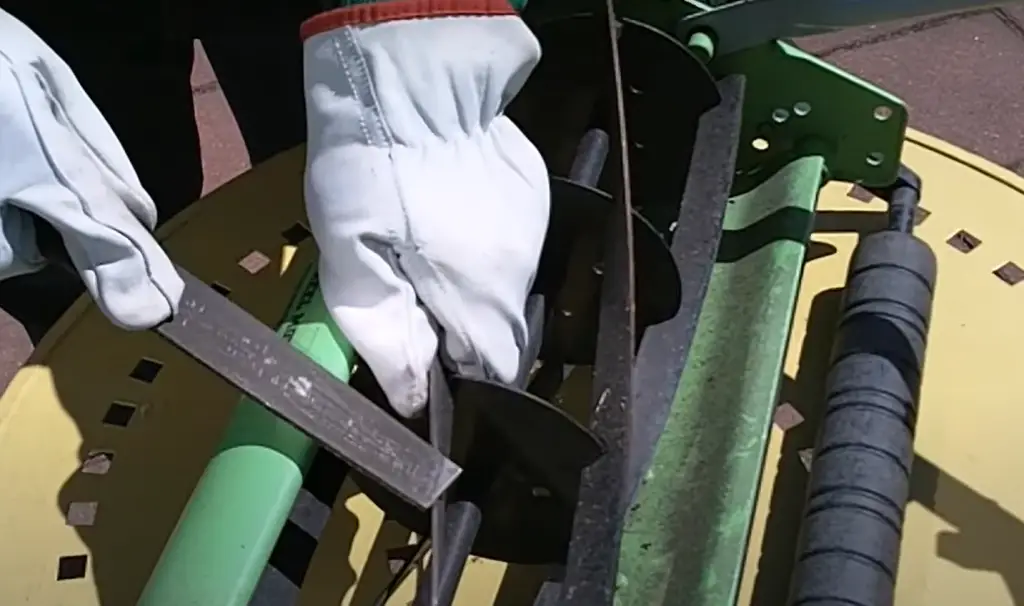
You can also use the mower for more specialized tasks such as aerating soil by removing bits of sod or creating patterns in your lawn with stripes or checkerboard designs. Additionally, because a reel mower is manual and requires no fuel to operate, it’s an environmentally friendly way to care for your lawn. All these benefits together make caring for your lawn with a reel mower a rewarding experience. [4]
How to Apply a Reel Mower?
Read the operator’s manual for your reel mower to familiarize yourself with its components and safety features.
- Carefully assemble the reel mower according to the instructions provided in the operator’s manual.
- Place the reel mower onto a flat, even surface that is free of debris, such as sticks or stones, which could interfere with mowing performance.
- Push down firmly on all four corners of the reel mower to ensure it is properly secured to the ground before use.
- Start by pushing the blade forward until it engages with grass at least 3 inches tall. This will help you gauge how high you need to keep your lawn cut in order for optimum performance from the mower.
- Position the reel mower behind you and begin pushing it forward in a straight line, keeping your arms close to your body for better control of the machine.
- Mow around any obstacles, such as trees or shrubs, by cutting in arcs rather than trying to go directly around them. This will help prevent turf damage from occurring due to overlapping cuts from the mower.
- When you reach the end of a row, turn around and start pushing back towards its beginning. Repeat this process until you have completed all areas that need to be cut with the reel mower.
- Check periodically throughout your lawn-mowing session for debris that may have become lodged in the reel mower’s blades. Use a stick or other tool to remove any debris.
- Once you have finished cutting your lawn with the reel mower, turn it off and disconnect the power source before cleaning it up and storing it away.
- Rake up any clippings left behind by the reel mower so they don’t encourage excessive weed growth in your yard. Following these steps will ensure success when using a reel mower on your lawn! [5]
How to Sharpen a Reel Mower?
- Prepare the mower and remove any debris that may be lodged in the blades. This can be done by raising the mower and using a brush to clear away any dirt, leaves, or other materials.
- Position the mower on a flat surface and then adjust the blade height setting as needed, as this will help create an even sharpening result.
- Securely fasten a file guide onto the blade of the reel mower, ensuring it is securely fixed in place before beginning to sharpen.
- Using a smooth stroke, begin to draw the file over each individual blade at an angle of approximately 15-20 degrees for optimal results. Make sure you are filing in one direction only – never back and forth – to avoid damaging the blade.
- Run a piece of sandpaper over the blades once finished filing, in order to smooth out any rough edges created during sharpening. This step is important for ensuring your mower blades remain safe and free from jagged edges that could cause injury or damage.
- Once you are satisfied with the results, reassemble your reel mower, check all bolts and screws are secure, and then test it by cutting some grass. This will help ensure you’re getting an even cut from your newly-sharpened blades. [6]
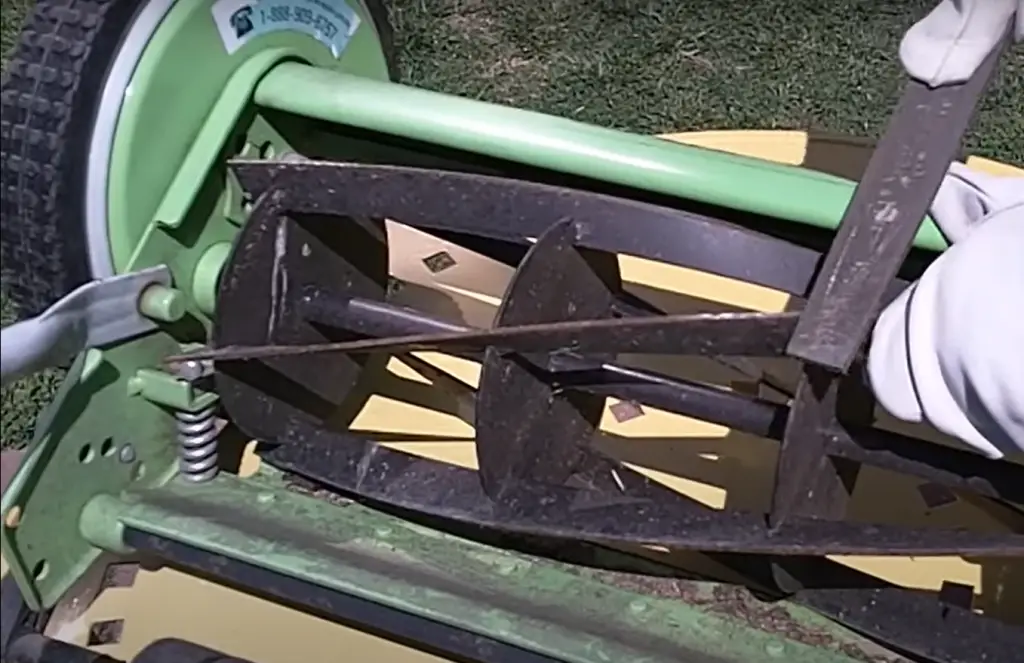
Finally, sharpen your reel mower regularly to keep it in top condition for optimal performance each time you use it.
How to Adjust Your Reel Mower Blades?
Adjusting the blades on a reel mower is an important part of keeping it well maintained. It is essential to get this right, as incorrect adjustment can lead to a poor cut and damage the lawn.
Begin by raising the handle on your reel mower so that it’s at its highest position and then turn off the power source if you are using an electric reel mower. Turn over the mower to expose the underside of the cutting blade assembly, which houses two blades. There will be several nuts or bolts that hold them in place; loosen these with appropriate tools such as wrenches or socket sets.
Using a feeler gauge, slide it in between both blades until they touch it lightly at two spots.
The exact width may vary depending on the reel mower model, so it’s best to consult your user manual or manufacturer website for details.Once the blades have been adjusted, hold them in place with the nuts and bolts and turn the mower back over. To check if you got it right, move your hand across both blades. They should be sharp enough to cut a piece of paper but not so sharp that it cuts your skin. If everything is good, you can start using your reel mower again!
Finally, it’s important to make sure that you regularly clean and sharpen your blades to keep them in good working order. This will ensure that the mower is able to cut grass efficiently and properly while also helping to reduce wear-and-tear on both the mower and lawn itself. [7
Adjusting your reel mower blades regularly will help you get a clean, even cut every time. With these simple steps, you can easily maintain your reel mower’s cutting performance for years to come!
Safety Precautions When Handling the Reel Mower
It is essential to take safety precautions to ensure your safety and prevent any injuries or accidents.
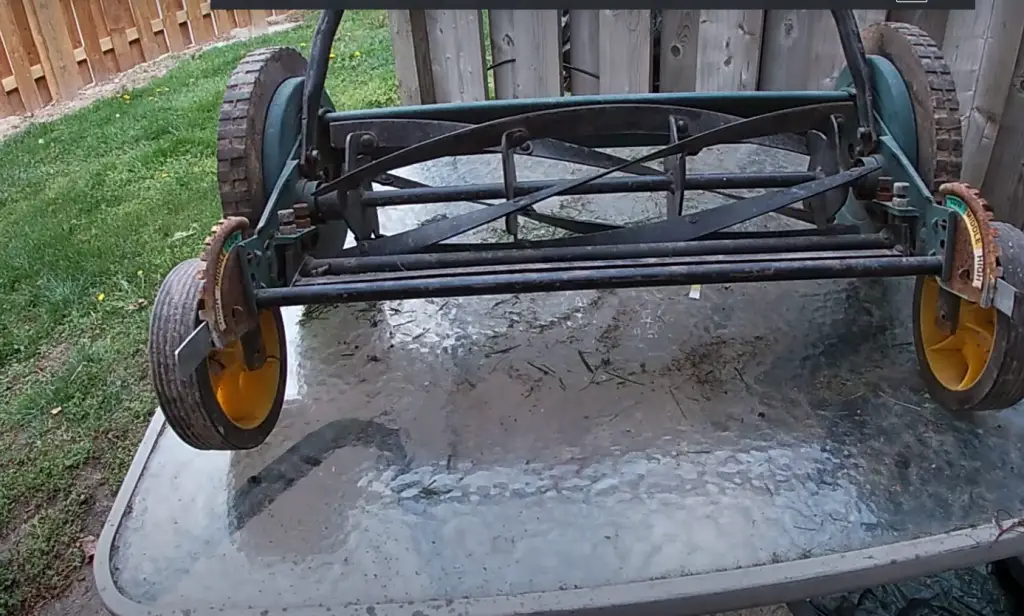
Here are some tips for safely operating a reel mower:
- Always wear protective gear when mowing, such as safety glasses, gloves and long trousers.
- Ensure that the lawn is clear of objects before beginning to mow. Anything that could be caught in the blades should be removed.
- Be aware of where the blades are located at all times. Avoid putting your hands anywhere near them while they are spinning or running.
- Make sure that any cords or wires around the area are kept out of reach to avoid entanglement with the blades.
- Never use a reel mower if it has been damaged in any way, as it could cause serious harm or injury.
- Do not attempt to sharpen the blades yourself – this should only be done by a professional.
- Keep children and pets away from the mower while in use, as they could get injured if they come too close.
- Always store the reel mower in a clean, dry place when not in use. This will ensure it stays in good condition and lasts longer.
- Make sure to read through the instructions manual carefully before using the reel mower for the first time. This will help you understand how to operate it properly and safely.
- Be sure to regularly inspect your reel mower for any damages or worn-out parts that need replacing. Regular maintenance will keep it running smoothly and efficiently for years to come! [8]
What Protective Gear Would Be Most Useful When Using a Reel Mower?
- Safety glasses: Eye protection is a must when using a reel mower, as flying debris and pieces of grass can be dangerous if they get in your eyes.
- Ear protection: The noise generated by the blades of the reel mower can be quite loud, so wearing ear protection is recommended to avoid damaging your hearing.
- Long pants and long-sleeved shirt: It’s important to cover up as much skin as possible while operating a reel mower, to avoid contact with the sharp blades.
- Leather gloves: Not only do these provide some grip while mowing, but also offer some extra protection from any shards of grass that might fly towards you.
- Steel-toed boots: Reel mowers can sometimes kick up rocks and other hard objects which could injure your feet, so wearing steel-toed boots can provide some extra protection.
- Hard hat: A hard hat is another important piece of protective gear to wear while operating a reel mower, as it will protect your head from any falling debris.
- Face shield: This is an optional item, but if you are concerned about the potential for grass and debris flying into your face then a face shield can be helpful in providing extra protection.
- Respirator mask: If you’re using a reel mower that generates fumes or particles that might be dangerous to breathe in then it’s recommended to use a respirator mask.
- Orange vest: If you plan on mowing in an area with a lot of foot traffic, wearing an orange vest will help make sure that passersby are aware of your presence and can avoid any potential accidents.
- Knee pads: This isn’t necessarily protective gear, but using knee pads while operating a reel mower can help keep your joints from getting too sore after prolonged periods of mowing. [9]
How to Extend the Life of a Reel Mower?
Taking care of a reel mower is an important part of keeping it in good condition and extending its life. Here’s what you can do to ensure your reel mower lasts for years to come:
- Sharpen the blades regularly. Reel mowers have several small blades that need to be sharpened periodically. A dull blade won’t cut grass efficiently, leading to poor performance and clumping. Using a file or grinder, sharpen each blade at least once per season or after every 20 hours of use.
- Clean the underside of the deck and other parts that come into contact with grass clippings regularly. This will help prevent dirt and debris from building up on the mower and reduce wear on the blades.
- Check for signs of rust or corrosion every few months and take steps to remove it if you find any. Rust can weaken your mower’s parts, making them less effective over time.
- Keep the reel well-lubricated with oil or grease that’s specifically designed for reel mowers. This will help prevent friction from grinding away at its parts and keep them running smoothly for longer.
- When not in use, store your mower indoors in a dry place to protect it from moisture and other elements that can cause damage over time. [10]
How To Understand When a Reel Mower Is Not Operable?
When a reel mower is not operable, there are certain indicators that will alert you. First, the blades on the reel mower should rotate freely when it is running. If they do not move easily or appear to be stuck in place, this could indicate a problem with the blades or the drive belt. Additionally, you should check for any visible signs of damage such as broken parts or cracks in plastic components. If your reel mower has a wheel alignment issue, you may notice that it pulls to one side while cutting and may require adjustment.
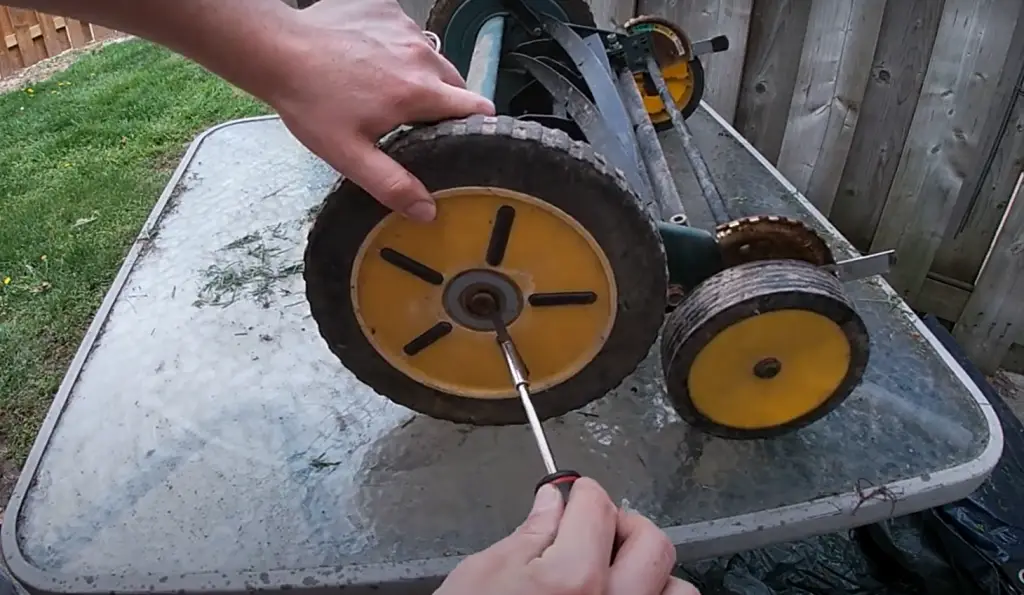
Another indication of an issue with your reel mower can be seen when trying to engage the engine. If it fails to start after several attempts, this could suggest that service is required.
Finally, the grass clippings may not appear to be cut evenly which can signify that the blades are dull and need sharpening or replacing. [11]It’s critical to regularly inspect your reel mower to ensure it is operating correctly and safely. If any issues are discovered, they should be addressed quickly before further damage occurs. Additionally, if any signs of wear and tear become visible or if you notice an overall decrease in performance over time, service may be required. Contacting a qualified technician who specializes in repairing reel mowers can provide additional assistance with troubleshooting any problems you may have encountered with your machine. [12]
Can a Reel Mower be Recycled?
Such tools can often be recycled at your local recycling center. Most centers accept reel mowers for scrap metal, which is then melted down and reused in other products. Alternatively, you can donate a working or nonworking reel mower to a local charitable organization or school that may be able to use it. Even if the mower is beyond repair, many parts of the mower such as the handles, wheels, axles, and blades can be repurposed into useful items in the home or garden. If all else fails, contact your local waste management department for more information on proper disposal options. As with any product made from metal or plastic components, disassembly and proper separation of materials prior to disposal will make the recycling process easier and more efficient.

Reel mowers are a great eco-friendly alternative to traditional gas-powered mowers, which produce pollution and noise that can disturb the environment. By opting for a reel mower instead, you’re helping to reduce your carbon footprint and keep valuable resources out of landfills. Recycling or donating your old reel mower is an easy way to do your part in protecting the planet. [13]
FAQs
Do you need to sharpen reel mower blades?
Yes, reel mower blades should be sharpened regularly to ensure that the lawn is cut properly. Depending on how often you use your reel mower, sharpen your blades at least once or twice a year. If you’re using your mower frequently, it may be necessary to sharpen more frequently.
How often do you sharpen blades on a reel mower?
Sharpening the blades of a reel mower is an important part of regular maintenance. Most manufacturers recommend sharpening the blades every three to five mowing sessions, depending on the amount and type of grass being cut. If you notice your mower struggling with thick or tall grass, it may be time for a sharpening session. To sharpen your blades, use a sharpening stone and apply light pressure while running the stone along each blade in one direction only. Finally, make sure to wipe down all surfaces after sharpening and lubricate any moving parts with oil as needed. Taking these steps regularly will ensure your reel mower continues to provide excellent performance season after season.
What angle do you sharpen a reel mower?
When sharpening a reel mower, the correct angle for sharpening the blades is between 20 and 30 degrees. It is important to ensure that all blades are set to the same degree of sharpness in order to maintain an even cut.

The angle should be measured with a protractor or other angle measuring tool. Take care when setting the angle as too shallow or too steep can cause damage to the cutting edge of the blade. A sharpening stone or file should be used at a slow speed across the blade’s cutting edge, applied in small circles to ensure an even grind and provide sufficient honing of the blade edges. After each pass with your sharpening stone, check your progress against your protractor and adjust accordingly if needed until you reach the desired angle.
Can a reel mower cut wet grass?
In general, a reel mower is not designed to cut wet grass. Wet grass can clog the blades and make them difficult to push through the grass. Additionally, wet grass can be difficult to mulch and may leave uneven patches on the lawn. If you need to mow your lawn when it’s wet, then an electric or gas-powered rotary mower might be better suited for the job. These types of mowers are designed specifically for cutting through thick, wet grass with ease. However, if you want a more eco-friendly solution or prefer the traditional look of a reel mower, there are some models that are designed with extra wide blades and other features that help them handle tougher conditions like wet grass. Be sure to read the product specifications of any reel mower you’re considering so that you know what conditions it is designed for.
Useful Video: Best way to sharpen reel lawn mower blades – How to sharpen a push mower
To Sum Up
In summary, lawn care can be tedious and time-consuming but the right tools can make the job easier. The reel mower is a great choice for both residential and commercial lawns because it offers many advantages that traditional power mowers do not. It’s quieter than gas-powered mowers, it’s better for the environment, it’s lightweight to maneuver, and best of all, it has an easy sharpening process which you can do yourself at home without too much hassle or expense. With its many benefits, the reel mower continues to demonstrate that it is an effective and reliable tool for maintaining a lush, healthy lawn year after year!
References:
- https://fgadamsonandson.co.uk/blogs/lawnmower-help/types-of-lawn-mowers-explained
- https://www.electronicshub.org/lawn-mower-types/
- https://home.howstuffworks.com/reel-mower.htm
- https://gardentherapy.ca/reel-mower/
- https://www.thespruce.com/reel-mowers-review-2130983
- https://www.urbanorganicyield.com/reel-mower-sharpening/
- https://www.ehow.com/how_5086369_adjust-blades-reel-mower.html
- https://www.michiganmedicine.org/health-lab/9-essential-lawn-mower-safety-rules-know-you-mow
- https://extension.umn.edu/lawn-care/mowers-and-mowing-safety
- https://www.erieinsurance.com/blog/extend-life-of-lawn-mower
- https://fixitclub.com/yard-garden-repairs/reel-lawn-mower-repair/
- https://lawnmowerguru.com/reel-mower-not-spinning/
- https://goloadup.com/recycling-old-lawn-mowers/





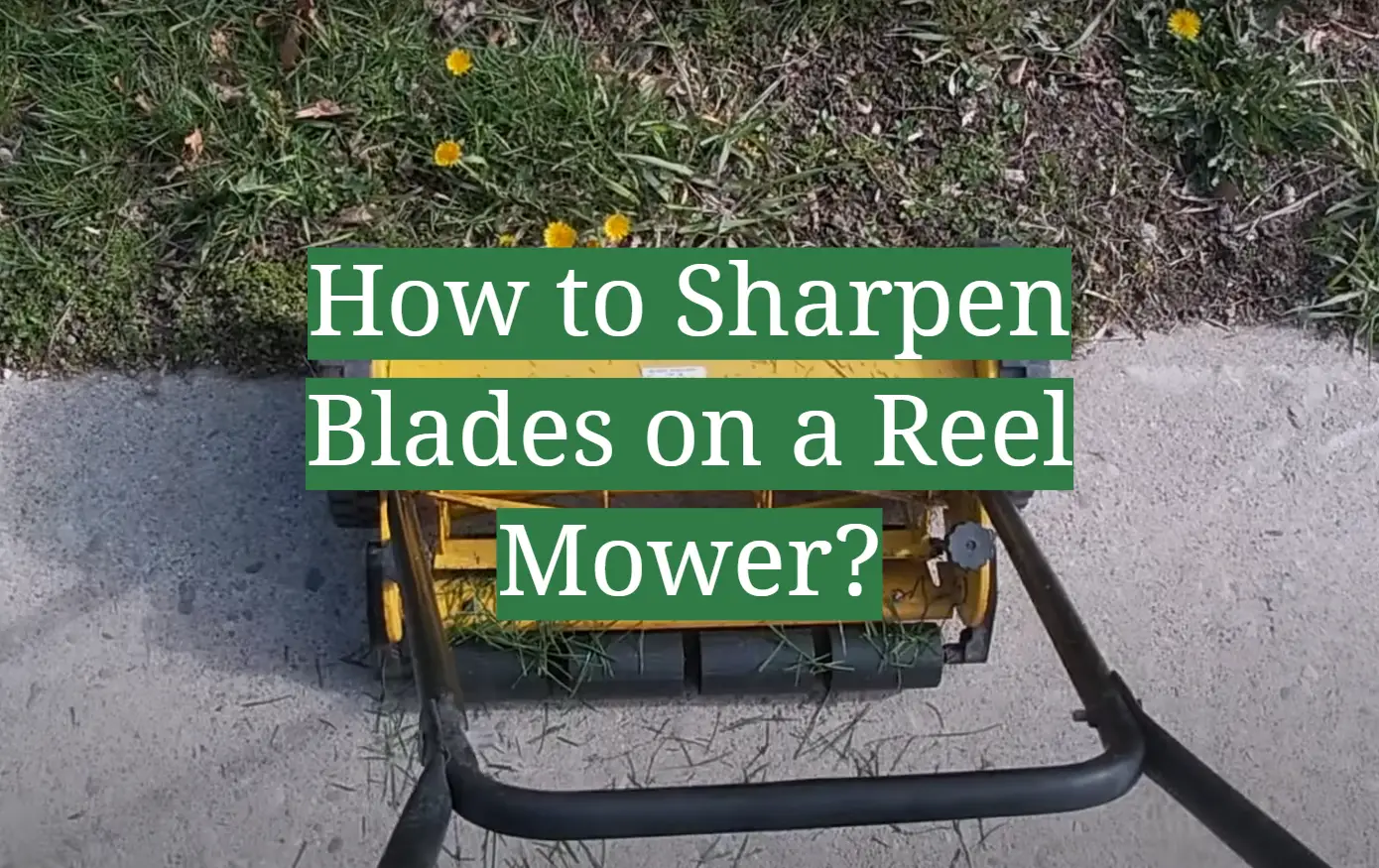




Leave a Reply
View Comments